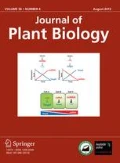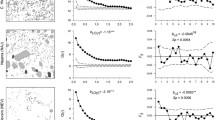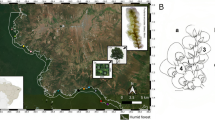Abstract
We investigated the morphological and genetic variations found inSuaeda maritima growing on sand dunes at Jogeum-naru, Muan-gun, in Korea. Our objective was to determine how plant density, biomass, and morphological characteristics were affected by habitat and environmental factors. Differences in elevation dictated that habitats for this species be divided into three positions: low, middle, and high areas. The higher the elevation, the lower the amount of available water, total nitrogen, phosphate, and organic matter. Correlations between biomass and environment were statistically significant For example, plant density and biomass declined as elevation increased. In low areas, the lengths of aerial stems and leaves were 17.98±0.46 and 7.83±0.12 mm, respectively; values measured at high areas were 0.70 and 0.83 times smaller, respectively. Likewise, lengths of main roots in low areas were 8.06± 0.21 mm; in higher areas, roots were 1.58 times longer. Leaf widths in low areas were 1.88±0.01 mm, and 1.16 times greater at higher elevations. Values for these parameters in middle areas were intermediate between those for the other two. Nevertheless, when we used an MVSP computer program to conduct a similarity coefficient analysis, we found that the morphological variations recorded at the three elevations were not matched by differences in DNA patterns, although genetic variations were observed within individual populations.
Similar content being viewed by others
Literature Cited
Bray RH (1948) Correlation of soil tests with crop responses to added fertilizer requirements: Diagnostic technique for soils and crops. The American Potash Institute, Washington DC, pp 53–86
Brereton AJ (1971) The structure of the species population in the initial stages of salt-marsh succession. J Ecol 59: 321–338
Chapman VJ (1977) Wet Coastal Ecosystems. Elsevier Scientific Publishing Company, New York, pp 1–29
Cooper AC (1982) The effects of standing water and drainage potential on theSpartina alterniflora-substrate complex in a North Carolina marsh. Estu Coast Mar Sci 11: 41–52
Gottlieb LD (1977) Cenotypic similarity of large and small individuals in a natural population of the annual plantStephanomeria exiguassp. coronaria (Compositae). J Ecol 65: 127–134
Hancock JK, Jr, Bringhurst RS (1978) Inter-population differentiation and adaptation in the perennial diploid speciesFragaria vesca L. Amer J Bot 65: 795–803
Heley WJ, Lindley ST, Levavasseur G, Osmond CB, Rasmus L (1992) Photosynthetic response ofUlvarotundata to light and temperature during emersion in an inter-tidal sand flat. Oecologia 89: 519–523
Hsiao TC (1973) Plant responses to water stress. Annu Rev Plant Physiol 24: 519–570
Ihm BS (1987) The distribution and growth of halophytes at the coastal marsh. Bull Inst Litt Biot 4: 71–79
Ihm BS (1989) Distribution of coastal plant communities in response to soil water potential and plant osmotic adjustment. Ph. D. thesis. Seoul National University, Seoul
Ihm BS, Lee JS (1985) Effects of salinity on growth of plants. Bull Inst Litt Biot 2: 33–40
Jackson ML (1967) Soil Chemical Analysis. Prentice-Hall, New Delhi, pp 227–271
Jefferies RL, Davy AJ, Rudmik T (1981) Population biology of the salt marsh annualSalicornia europaea agg. J Ecol 69: 17–31
Jonathan MH, Jacqueline AP, Rob HM (2000) Influence of environmental factors on the growth and interactions between salt marsh plants: Effects of salinity, sediment and waterlogging. J Ecol 88: 492–505
Kim CS (1971a) An ecological study on the process of plant community formation in tidal land. Kor J Bot 14: 163–169
Kim CS (1971b) An ecological study on the plant community formation in tidal land. Kor J Bot 18: 129–134
Kim CS (1975) A study on standing crops inPhragmites communis communities and their environmental factors. Kor J Bot 18: 129–134
Kim JH, Min BM (1983) Ecological studies on the halophyte communities at western and southern coasts in Korea (III). Kor J Bot 26: 53–59
Lee CB (1980) Illustrated Flora of Korea, p 318
Lee JS (1990) On the establishment of halophytes along tidal level gradients at salt marshes of the Mankyong and Dongjin River estuaries. Ph. D. thesis. Seoul National University, Seoul
Lee KS, Oh GC (1989) Differences of Suaedajaponica populations from two different habitats in Sorae, Incheon, Korea. Kor J Ecol 12: 133–144
Lee WC (1996) Colored Standard of Korean Plants, p 624
Lee YN (1997) Flora of Korea, p 1237
McNaughton SJ (1966) Ecotype function in theTypha community type. Ecol Monogr 36: 297–325
Min BM (1985) Changes of soil and vegetation in reclaimed coastal lands, west coast of Korea. Ph. D. thesis. Seoul National University, Seoul
Ohwi J (1984) Flora of Japan, p 1066
Pazourkova Z (1973) Caryology of some forms ofPhrag-mites communis Trin.In S Hejny, ed, Ecosystem study on wetland biomes in Czechoslovakia. Czechosl IBP/ PT-PP Rep No 3. Trebon, pp 147–149
Roy A, Frascaria J, Mackay J, Bousquet J (1992) Segregation random amplified polymorphics (RAPDs) inBetula alleghaniensis. Theor Appl Genet 85: 173–180
Salisbury EJ (1942) The weed problem. Proc Royal Inst Gr Brit 31: 1–15
Seliskar DM (1985a) Morphometric variations of five tidal marsh halophytes along environmental gradients. Amer J Bot 72: 1340–1352
Seliskar DM (1985b) Effects of reciprocal transplanting between extremes of plant zones on the morphometric placity of five plant species in an Oregon salt marsh. Can J Bot 63: 2254–2262
Shea ML, Warren RC, Niering WA (1975) Biochemical and transplantation studies of the growth form ofSpartina alterniflora in Connecticut salt marshes. Ecol 56: 461–466
Shim HB, Jung JY, Choi BH (2001) A taxonomic study onLilium plants in Korea based on cluster analysis data. Kor J Plant Taxon 31: 381–386
Show AA, Vince SW (1984) Plant zonation in an Alaskan salt marsh. An experimental study of the role of edaphic conditions.) Ecol 72: 669–684
Smart RM, Barko JW (1980) Nitrogen nutrition and salinity tolerance ofDistichlis spicata andSpartina alterniflora. Ecol 61: 630–638
Stalter R, Batson WT (1969) Transplantation of salt marsh vegetation, Georgetown, South Carolina. Ecol 50: 1037–1089
Turesson G (1922a) The species and variety as ecological units. Hereditas 3: 100–113
Turesson G (1922b) The genotypical responses of the plant. Hereditas 3: 211–350
Ungar IA (1987) Population characteristics, growth and survival of the halophyteSalicornia europaea. Ecol 68: 569–575
Valiela I, Teal JM, Deuser WG (1978) The nature of growth forms in the salt marsh grassSpartina alterniflora. Amer Nat 112: 461–470
Zhang S, Renquing W, Xinshan Q, Weihua G and Baimin S (2004) Morphological and RAPD variation ofPhrag-mites australis along salinity gradient in the wetlands of the downstream of Yellow River, China. Kor J Ecol 27: 35–41
Author information
Authors and Affiliations
Corresponding author
Rights and permissions
About this article
Cite this article
Ihm, B.S., Myung, H.H., Park, D.S. et al. Morphological and genetic variations inSuaeda maritima based on habitat. J. Plant Biol. 47, 221–229 (2004). https://doi.org/10.1007/BF03030512
Received:
Accepted:
Issue Date:
DOI: https://doi.org/10.1007/BF03030512




